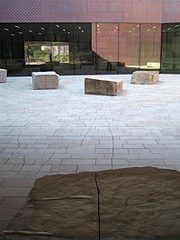 This morning’s Guardian hailed the fresh brilliance of the new Unilever Turbine Hall project at Tate Modern by Doris Salcedo.
This morning’s Guardian hailed the fresh brilliance of the new Unilever Turbine Hall project at Tate Modern by Doris Salcedo.
It shows: “a laudable unwillingness to compromise, wanting to make a work about absolute indifference, and to address desolation and destitution…Shibboleth begins with a hairline crack in the concrete floor by the entrance. As insignificant as a flaw in a teacup, as telling as the build-up scenes of a disaster movie, the crack soon widens and deepens, a jagged crevasse making its jagged way the length of the Turbine Hall, 167 metres away, jabbing a fork of lightning and deepening as it goes. You can never quite see the bottom of it.”
The double page picture spread in this morning’s Guardian centrefold does give a good impression of just how massive this new work of art is, and how astonishing the feat of engineering.
But is Shibboleth really as, er, groundbreaking as it appears?
I haven’t seen the “piece” or the “installation” or whatever it is called, but I have been to the De Young Museum in the Golden Gate park in San Francisco, where there is a very similar conceit by our own Andy Goldsworthy called Faultline, inspired by the unique character of California’s tectonic topography. Here’s the link if you want to check it out.
“Working with the Appleton Greenmoore stone imported from Yorkshire, England, that will surround the new de Young building, Goldsworthy has created a continuous crack running north from the edge of the Music Concourse roadway in front of the museum, up the main walkway, into the exterior courtyard, and up to the main entrance door.
Timothy Anglin Burgard, the Ednah Root Curator of American Art: “This minimalist work will have a subtly subversive quality, challenging the viewer’s notion of what constitutes a work of art by blurring the distinction between the natural and the man-made, while also drawing attention to nature’s potential to undermine or destroy the works created by humans.”
According to the OED, shibboleth means a custom, principle, or belief distinguishing a particular class or group of people. The Hebrews used the word – which means an ear of corn – as a test of nationality because it was difficult to pronounce. I’m not sure how the title of the piece, however, is supposed to help us with our interpretation of the work, or should I say their work.
Andy Goldsworthy is from the North (Cheshire, Yorkshire) and Doris Salcedo was born two years later in 1958 in Colombia.
So it is interesting to note how closely their art in this case seems to be related, though we may not quite – as The Guardian warns – ever see the bottom of it.






Comments